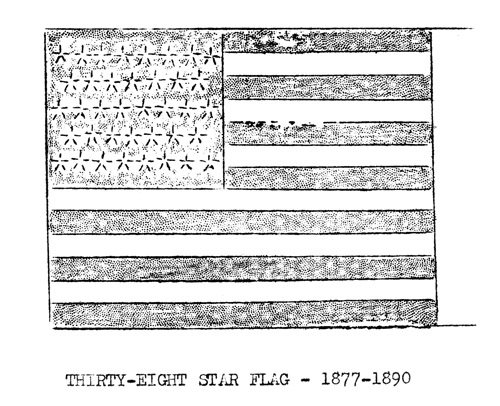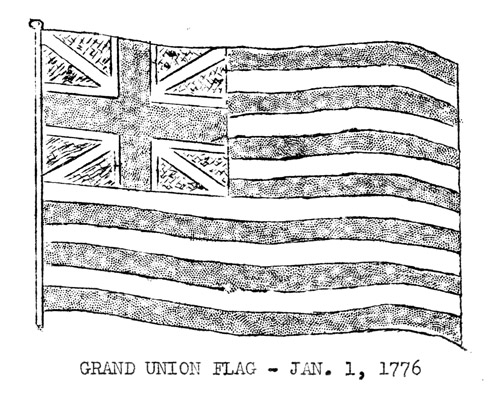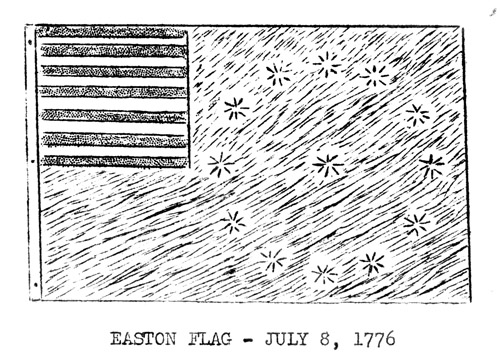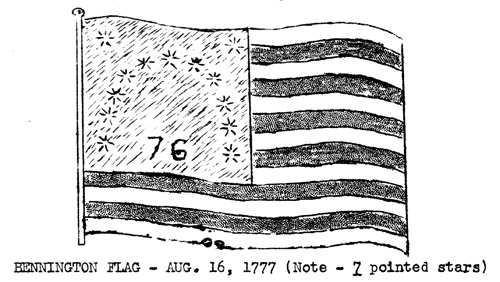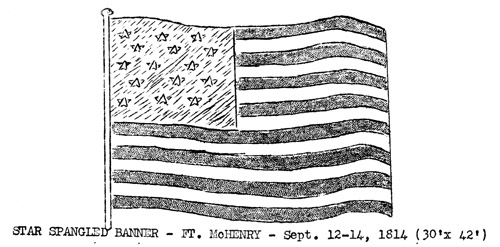|
Home : Quarterly Archives : Volume 14 |
Tredyffrin Easttown Historical Society |
|
Source: October 1966 Volume 14 Number 2, Pages 32–39 The Thirty-eight Star American Flag In 1956, this United States flag was given to the Tredyffrin Easttown History Club by Mrs. Elinor C. J. Sensenig, a member of the Club, who found it in 1953-54 in the attic of a house which she had previously owned. The house, no longer standing, was located between Old State Road and the Trenton Cut-Off of the Pennsylvania Railroad on its south side. The land was known as "The Reese Tract". In 1868 the house was owned by Charles and Margaret Thompson, who sold it to Jesse M. Hyselman. When the latter died, his estate was managed by Winfield S. Wilson as executor, until 1890, when the house was sold to A. Harry Bowen. This is the period of years in which the flag was made. The flag measures 62" by 56" and is completely hand made of wool. It has the traditional 13 stripes and 38 five-pointed stars.
Thirty-eight star flag - 1877-1890 How did flags originate? Why do we have them? It is practically certain that the use of a flag of any kind originated on ships at sea. This was because ships needed some way to recognize each other at a distance. A flag on a ship established its identity. On land, during the Middle Ages, flags were carried, or flown by owners of forts and castles for the same reason. They indicated possession. Later on, a flag would be flown on the authority of a state or a nation to indicate its supremacy. A flag, therefore, is important to a people as a symbol of their unity and nationality. Before the American Revolution, the colonies used various flags of their own devising in order to distinguish their ships. These flags usually derived from various British flags. In 1776, during the Revolution, a national flag was needed and wanted. The first "American" flag was hoisted near the headquarters of General Washington outside of Boston, Mass., probably near Somerville or Cambridge. This flag had several names:- The Continental Flag, or the Cambridge Flag, or the Great Union, among others. Most generally it has been called the "Grand Union" flag. It rather resembled later American flags, with seven red and six white stripes. But in the "canton", which is the oblong section nearest to the mast, instead of having stars it contained the British Union insignia.
Grand Union Flag - Jan. 1, 1776 One theory for the reason for this design is that the thirteen colonies were symbolized by the thirteen stripes. The British Union, used in the canton, may have been used to prove that loyalty still existed and that hope persisted that the colonies would not have to break away entirely. This is only a theory however. The Grand Union Flag was probably carried by General Washington across the Delaware River on Christmas night, 1776. This contradicts the famous painting by Emanuel Leutze, who might have been misinformed, or was purely imaginative in his depiction of the crossing. This flag probably floated over the headquarters of the Continental Army in Morristown, N.J., that winter also. How did our official United States flag originate? Why was it designed as it was? Who did it? There are at least five legends explaining this, but not one of them has ever been proved to be true. The Betsy Ross story first appeared in 1870 when her grandson, William J. Canby, read a paper about her at the Historical Society of Pennsylvania. In it he related his conversations with his Grandmother, Mrs. Ross, when he was eleven and she was eighty-four. It is true that Mrs. Ross was a needlewoman and a patriot. She had made some naval flags for which she had been paid, but the famous picture of her sewing on the Stars and Stripes, and the home alleged to have been hers have never been authenticated. The design, attributed to her, of the flag with the stars in a circle on the canton is, it is true, found on one of the proposed designs for a National Seal submitted in 1782, to the Congress. Another legend claims Long Island as the birthplace of our flag. John Hulbert, of Suffolk County, New York, had been active at Ticonderoga as captain of a company of Long Island minute men. In 1926, 150 years after his army discharge, a tattered old flag was found in his house. Some people thereafter claimed that this was an "original United States flag." It does seem likely that the flag is of the Revolutionary period from its workmanship and its 13 stars, but the diaries and dates of Hulbert's meetings with the Continental Congress leave gaps in the history of the flag and the dates of its design. Another school of historians connected the official design of the United States flag with the coat of arms of an early ancestor of George Washington. This theory seems unlikely mostly because the heraldic details differ greatly. Also, it seems most unlikely that General Washington would have permitted the use of a personal family coat of arms for this purpose. Moreover, the American people would hardly have wanted an English derivation for their flag at that time. There was one theory on the origin of our flag which dates back to Francis Hopkinson of New Jersey, one of the signers of the Declaration of Independence. He was a scholar, a student of history and heraldry, and he served his country in several governmental capacities. In 1780 he wrote to the Congress:-"I have with great readiness, on several occasions, exerted my abilities...for the public service, as I flatter myself, to the satisfaction of those I wish to please, viz: "The Flag of the United States of America Seven devices for the Continental Currency A Seal for the Board of Treasury A Great Seal for the United States of America..." He added that he would like a "quarter cask of the public wine as a proper and reasonable reward..." Congress declined to pay this, and also refused his subsequent request for 2700 pounds, saying that "the report relative to the fancy-work of F. Hopkinson ought not to be acted on." The Treasury Department also decreed that Hopkinson could not rightly claim authorship of the designs. Had these requests been granted, perhaps the origin of the flag would be confirmed, but this was not the case. A fifth legend interests us, since it concerns nearby Easton, Pennsylvania. In 1959 (and we presume thereafter), the Easton Public Library had a curious flag. It reverses the placement of the traditional design, with the 12 red and white stripes in the canton, and the 13 white stars are in a blue field in the main section (called the "fly"). The stars have eight points.
Easton Flag - July 8, 1776 Some people thought at one time that this was the flag which was raised over the Easton courthouse at the time of the first reading of the Declaration of Independence on July 8, 1776, but this has never been proved. Others report that this flag was made locally in 1814. Bu if it had been made in 1814, it would most likely have had 15 stars and 15 stripes. The likelihood is that this flag is an original military flag made for Captain Abraham Horn's Northampton County troop in the war of 1812. What flag, then, is the real, original United States flag? As of now, it is pretty well accepted that the first truly American flag with thirteen stars and thirteen stripes appeared at the Battle of Bennington in August 1777, when the German Commander Baum was sent by Burgoyne to meet the American forces under General John Stark. Stark exhorted his men "Tonight the American flag floats over your hill or Molly Stark sleeps a widow". This flag was given to the Bennington Historical Museum by the descendants of Nathaniel Fillmore, a member of the militia which fought there. (His grandson was Millard Fillmore, 13th president.) It is practically certain that this Bennington flag is the oldest known American flag, and also the first one to have been used by any United States land force and to have been raised in victory in the War of Independence.
Bennington Flag - Aug. 16, 1777 (Note - 7 pointed stars) Before 1818 there were many variations in the design of the flag. No definite law stated how big the stars or stripes should be or how many points the stars should have. Some flags, previous to 1818, had 8,7,6, or 5-pointed stars, sometimes arranged in straight rows and sometimes not. The arrangement of the stars in a circle seems to have derived from popular paintings and there is no evidence that this design was ever really popular, or, indeed authentic. American and foreign publishers, printers, and painters often made the flag look as they thought it might in their publications and paintings. Perhaps they were misinformed, since there was no official pronouncement describing the authentic flag. In 1818, after the War of 1812, it seemed obvious that legislative action was in order. Four states had been admitted without representation on the flag by either stars or stripes. Peter Wendover, a Congressman from New York, drew up a proposed bill. He and his consultants determined that the practice of adding a stripe, as well as a star, for each state admitted would eventually make the flag look like a "strip of peppermint-striped suiting." In time the stripes would have to be so narrow that they would be only thin lines. Several alternative ideas were presented, but, in 1818, after much delay, Wendover's bill, called "An act to Establish the Flag of the United States" was passed. Now it was legally enacted that the stripes should be horizontal (which had not always been the case). The arrangement of the stars was not specified and has not been to this day. The new flag with 20 five-pointed stars and 13 stripes was designed by Captain Chester Reid (1783-1861), and made by his wife in 1818. During the Civil War there were many unauthorized flags flown by various states and by various military units of both the North and the South. Many proposals were made to alter the official design of the national flag. Samuel F. B. Morse suggested that the flag be cut in half diagonally with 20 stars and 6 1/2 stripes retained by the North and the rest by the south. Some wanted the stars representing the southern states to be deleted. Some even wanted to omit the stars representing the border states. President Lincoln adamantly refused to consider any change. To him the seceding states still belonged in the Union and so the stars remained. Perhaps the most famous story about the Stars and Stripes is the well-known one of Barbara Frietchie, the 97-year old Unionist in Frederick, Maryland. This story is suspected by David Eggenberger, author of "Flags of America". After the publication of the poem, another lady named Mary A. Quantrill claimed that she was the heroine after the war. This is interesting to the writer of this paper. In the 1920's, my neighbor in Wayne, Pennsylvania, was a Mr. Joseph Stockwell who, as I remember it, was descended from residents of Frederick, Maryland. I clearly remember him telling me that Mrs. Frietchie was far too old and bedridden to have waved the flag from the second-story window, and that it was a nurse-companion who had done it. So it may be that this second lady described by Mr. Stockwell was Mary A. Quantrill in 1862. In 1800 for the first time in history of this country a national flag was raised over the Capitol in Washington. This flag of 15 stars and 15 stripes is the famous flag flown over Fort McHenry in September 1814. The original, with eleven holes shot in it, was hand made in Baltimore and measures 30 by 42 feet. It hangs in the Smithsonian Institution.
Star Spangled Banner - Ft. McHenry - Sept. 12-14, 1814 (30' x 42') In July, 1877, one hundred years after its founding, the United States added a 38th star to its flag, representing Colorado. This is the flag which we have been given and the flag of the nation from 1877 to 1890. Five presidents served under it: Hayes, Garfield, Arthur, Cleveland, and Harrison. These thirteen years were a period of relative peace, of interior growth and expansion. The Republic now began to be an international power and an industrial empire. The same Stars and Stripes which it created even flew briefly over the Northernmost land ever reached by man when Adolphus W. Greely carried it to within 497 miles of the North Pole. The flag now represented more than 3,000,000 square miles of the United States and more than 40,000,000 Americans. It now was an honored symbol. Its red stripes symbolize valor and its white symbolize hope and purity. The blue of the canton represents the heavens and our reverence for God. The stars relate the separate sovereignty of the states they mark. Today the flag means as much to us as it did to our struggling ancestors. It is probably the third oldest national flag in use in the world. "It bears witness to the immense expansion of our nation, to the splendid structure of our government. Its spirit is the spirit of the American nation. Its history is the history of the American people. Heroes have died for it. It is the visible sign of the spirit that brought liberty and prosperity to the people of the United States. Let us accord it honor and loyalty." TopBibliography Eggenberger, David. "Flags of the U.S.A." The Crowell Co. 1959. Kannik. "The Flag Book," The Branner Press. 1957. Carr. "Flags of the World." Warne & Co. 1953. "The Flag Code." National Society of the Daughters of the American Revolution. Revised & endorsed at the Second National Flag Conference. 1924. Schermerhorn. "American and French Flags of the Revolution." Published by the Pennsylvania Sons of the Revolution. Philadelphia, Pa. 1948. |
